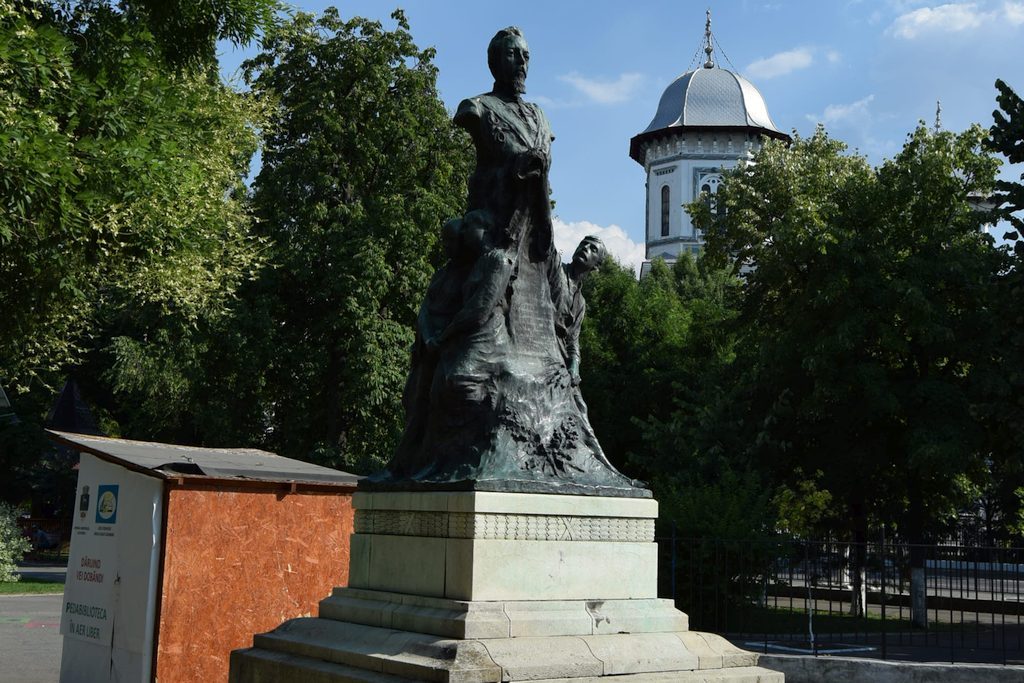

The bust of Alexandru Ioan Cuza is executed by the sculptor I. Iordănescu in the year 1914, being an allegorical statue.
Alexandru Ioan Cuza (or Alexandru Ioan I; born on the 20th of March 1820, Bârlad, the Principality of Moldavia, today in Romania – the 15th of May 1873; Heildelberg, Germany) was the first prince of the United Principalities and of the national state of Romania. He actively participated at the revolutionary movement from 1848 from Moldavia and at the fight for the union of the Principalities. On the 5th of January 1859, Cuza was chosen prince of Moldavia, and on the 24th of January 1859 and of Wallachia, being performed in this manner the union of the two principalities. Becoming a prince, Cuza led a sustained political and diplomatic activity for the recognition of the union of Moldavia and of Wallachia by the Suzerain Power and the Guarantee Powers and then for the accomplishment of the union of the Romanian Principalities on the path of executing the constitutional and administrative unity, which was executed in January 1862, when Moldavia and Wallachia formed a unitary state, adopting officially, in 1862, the name of Romania and forming the modern Romanian state, with the capital at Bucharest, with only one gathering and only one government.
Cuza was forced to abdicate in the year 1866 by a large coalition of the parties from that period of time, named the Monstrous Coalition, because of the different political orientations of its members, who reacted in this manner towards the authority manifestations of the prince.
Cuza was forced to abdicate in the year 1866 by a large coalition of the parties from that
The reign of Cuza Vodă has been characterized by an impatient desire of catching up the Occident, but the effort of the prince and of his supporters encounters the resistance of the conservatory forced and of the collective inertia. More seriously, he stands under the sign of the provisionality, because of the fact that the reign of Cuza is percept as passenger; the country wished for a foreign prince, but they accepted the autochthonous one, but they didn’t give up to their former desire; in the await of the beneficent context, it allows a provisionality.
After the execution of the union, the prince Alexandru Ioan Cuza and his closest collaborator, Mihail Kogălniceanu (minister, then prime-minister of Romania), he initiates important internal reforms: the secularization of the monastery fortunes (1863), the agrarian reform (1864), the reform of education (1864), the reform of justice (1864) and others, which fixed a modern frame for developing the country.
Encountering resistance from the part of the Government and of the Legislator Gathering, formed by the representative of the aristocracy and the of the great bourgeoisie, as well as of the church, in accomplishing some reforms, Cuza forms, in 1863, a government under the command of Mihail Kogălniceanu, which performs the secularization of the monastery fortunes (December 1863) and dissolves the Legislator Gathering (the coup d’etat from the 2nd of May 1864). In the same year, Cuza subjects to the approval of the people, by a plebiscite, a new constitution and a new election law, meant to ensure the Parliament a broader base, and decrees (the 14th of August 1864) the rural law conceived by Kogălniceanu. During the times of the reign of Cuza it was conceived the civil code and the Penal code of French inspiration, the law for the compulsoriness of the primary education and they were founded the first universities from the country, namely the one from Iași (1860), which today bears his name, and the one from Bucharest (1864). Also in this period it was organized also the national army.
